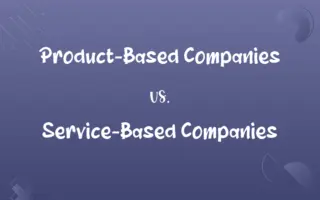LIFO vs. FIFO: Know the Difference

By Shumaila Saeed || Published on January 28, 2024
LIFO (Last In, First Out) refers to processing the most recent item first, while FIFO (First In, First Out) processes the earliest item first.

Key Differences
LIFO, standing for "Last In, First Out," is an inventory management method where the most recently produced or acquired items are used or sold first. In contrast, FIFO, or "First In, First Out," prioritizes the oldest stock, using or selling items in the order they were added. These methods significantly impact inventory valuation and financial reporting.
Shumaila Saeed
Jan 28, 2024
In accounting, LIFO assumes that the last items added to inventory are the first to be removed, leading to newer stock being sold or used first. This contrasts with FIFO, where the first items added to inventory are the first to leave, ensuring the oldest stock is utilized initially. This approach affects the cost of goods sold and can influence a company's profitability.
Shumaila Saeed
Jan 28, 2024
In the context of data structures in computing, LIFO is akin to a stack where the last element added is the first to be accessed or removed. Conversely, FIFO operates like a queue, where the first element added is the first to be accessed, ensuring a chronological order of processing. These methods are fundamental in programming and system design.
Shumaila Saeed
Jan 28, 2024
When considering the impact on taxes, LIFO can result in lower taxable income in times of rising prices, as the cost of goods sold is higher. FIFO, on the other hand, may lead to higher taxable income under the same conditions because the older, often cheaper stock is sold first. Companies choose between these methods based on their financial strategy and market conditions.
Shumaila Saeed
Jan 28, 2024
In supply chain management, LIFO is less common but can be practical in specific industries where newer items are more desirable. FIFO is widely used across various sectors, particularly in food and healthcare, where expiration dates and product freshness are critical. These inventory strategies are crucial in ensuring efficiency and customer satisfaction.
Shumaila Saeed
Jan 28, 2024
ADVERTISEMENT
Comparison Chart
Inventory Valuation
Values the newest inventory, often leading to higher costs.
Values the oldest inventory, often leading to lower costs.
Shumaila Saeed
Jan 28, 2024
Profit Reporting
Can lower reported profit during inflation.
Can increase reported profit during inflation.
Shumaila Saeed
Jan 28, 2024
Tax Implications
May result in lower taxes in periods of rising prices.
May lead to higher taxes in periods of rising prices.
Shumaila Saeed
Jan 28, 2024
Suitability
Preferable for non-perishable goods or where newer items are prioritized.
Ideal for perishable goods or where product freshness is key.
Shumaila Saeed
Jan 28, 2024
Data Structure Analogy
Similar to a stack in programming.
Comparable to a queue in programming.
Shumaila Saeed
Jan 28, 2024
ADVERTISEMENT
LIFO and FIFO Definitions
LIFO
An inventory method where the last items added are the first to be used or sold.
The warehouse operates on a LIFO basis, so the most recently delivered goods are dispatched first.
Shumaila Saeed
Jan 06, 2024
FIFO
In computing, a queue-based data structure where the first element added is the first removed.
The printer's job queue is managed using FIFO, printing documents in the order received.
Shumaila Saeed
Jan 06, 2024
LIFO
An accounting approach impacting cost of goods sold by using the latest inventory prices.
The company's LIFO accounting led to higher costs on the income statement as prices rose.
Shumaila Saeed
Jan 06, 2024
FIFO
An accounting method that calculates the cost of goods sold based on the oldest inventory costs.
Under FIFO, the company's lower cost of older inventory resulted in higher profits.
Shumaila Saeed
Jan 06, 2024
LIFO
In computing, a data structure where the last element added is the first to be removed.
The program's undo feature uses a LIFO stack to reverse the most recent actions.
Shumaila Saeed
Jan 06, 2024
ADVERTISEMENT
FIFO
An inventory management strategy where the first items acquired are the first to be sold or used.
The supermarket employs FIFO, ensuring older produce is sold before newer arrivals.
Shumaila Saeed
Jan 06, 2024
LIFO
In logistics, a method where newer stock remains unsold or unused until older stock is depleted.
The storage facility's LIFO approach meant that older items were always at the front.
Shumaila Saeed
Jan 06, 2024
FIFO
A stock rotation system ideal for perishable goods to prevent spoilage.
The FIFO system in the pharmacy ensures that medications with earlier expiration dates are used first.
Shumaila Saeed
Jan 06, 2024
LIFO
A stock management system often leading to inventory layers.
Their LIFO system resulted in different layers of inventory, each valued at different prices.
Shumaila Saeed
Jan 06, 2024
FIFO
In logistics, a method ensuring that products are sold or used in chronological order.
Shumaila Saeed
Jan 06, 2024
LIFO
Inventory accounting in which the most recently acquired items are assumed to be the first sold
Shumaila Saeed
Jan 05, 2024
FIFO
An accounting method in which goods in inventory are valued at the price of the most recent acquisition of each type of goods, and those used up from inventory are valued at the cost of those first acquired.
Shumaila Saeed
Jan 05, 2024
FIFO
Inventory accounting in which the oldest items (those first acquired) are assumed to be the first sold
Shumaila Saeed
Jan 05, 2024
Repeatedly Asked Queries
How does LIFO work?
LIFO assumes that the most recently acquired or produced items are the first to be sold or used, resulting in the oldest items being valued in inventory.
Shumaila Saeed
Jan 28, 2024
What are the advantages of LIFO?
LIFO can reduce income taxes during periods of inflation, as it matches higher cost items with current revenue.
Shumaila Saeed
Jan 28, 2024
How does FIFO work?
FIFO assumes that the oldest items in inventory are the first to be sold or used, resulting in the most recently acquired items being valued in inventory.
Shumaila Saeed
Jan 28, 2024
What industries commonly use LIFO?
LIFO is often used in industries with fluctuating or rising costs, like retail and manufacturing.
Shumaila Saeed
Jan 28, 2024
What is FIFO?
FIFO stands for First-In, First-Out, which is another method of inventory valuation.
Shumaila Saeed
Jan 28, 2024
What is LIFO?
LIFO stands for Last-In, First-Out, which is a method of inventory valuation.
Shumaila Saeed
Jan 28, 2024
What are the disadvantages of LIFO?
LIFO can distort the true value of inventory and may not reflect the physical flow of goods. It can also lead to higher income taxes in deflationary periods.
Shumaila Saeed
Jan 28, 2024
What are the advantages of FIFO?
FIFO provides a more accurate reflection of the physical flow of goods and is less likely to distort the value of inventory.
Shumaila Saeed
Jan 28, 2024
Can a company switch between LIFO and FIFO?
Yes, but it typically requires approval from tax authorities and can have financial reporting implications.
Shumaila Saeed
Jan 28, 2024
What are the disadvantages of FIFO?
FIFO can result in higher income taxes during inflationary periods since it matches lower-cost items with current revenue.
Shumaila Saeed
Jan 28, 2024
What factors should a company consider when choosing between LIFO and FIFO?
Factors include industry, inflation rate, tax implications, and financial reporting needs.
Shumaila Saeed
Jan 28, 2024
Are there alternative inventory valuation methods besides LIFO and FIFO?
Yes, there are other methods like weighted average cost and specific identification, but LIFO and FIFO are the most widely used.
Shumaila Saeed
Jan 28, 2024
Which industries commonly use FIFO?
FIFO is often preferred in industries with stable or declining costs, such as food and perishable goods.
Shumaila Saeed
Jan 28, 2024
Which method is better for financial reporting purposes?
FIFO is generally preferred for financial reporting, as it provides a more accurate reflection of a company's financial position.
Shumaila Saeed
Jan 28, 2024
Which method is better for tax purposes?
LIFO is often preferred for tax purposes, especially during periods of inflation, as it can reduce taxable income.
Shumaila Saeed
Jan 28, 2024
Do international accounting standards favor LIFO or FIFO?
International accounting standards typically favor FIFO, while LIFO is primarily used in the United States.
Shumaila Saeed
Jan 28, 2024
What are the key differences between LIFO and FIFO?
The main difference is the order in which items are assumed to be used or sold: last-in, first-out for LIFO, and first-in, first-out for FIFO.
Shumaila Saeed
Jan 28, 2024
What are the consequences of using the wrong inventory method for a business?
Using the wrong method can lead to inaccuracies in financial statements and tax liabilities that may not align with a company's actual operations.
Shumaila Saeed
Jan 28, 2024
Can a company transition from LIFO to FIFO or vice versa?
Yes, but it may involve complex accounting adjustments and tax considerations.
Shumaila Saeed
Jan 28, 2024
How do LIFO and FIFO impact inventory management?
They influence how inventory costs are allocated and can impact a company's profitability and financial statements.
Shumaila Saeed
Jan 28, 2024
Share this page
Link for your blog / website
HTML
Link to share via messenger
About Author
Written by
Shumaila SaeedShumaila Saeed, an expert content creator with 6 years of experience, specializes in distilling complex topics into easily digestible comparisons, shining a light on the nuances that both inform and educate readers with clarity and accuracy.








































































